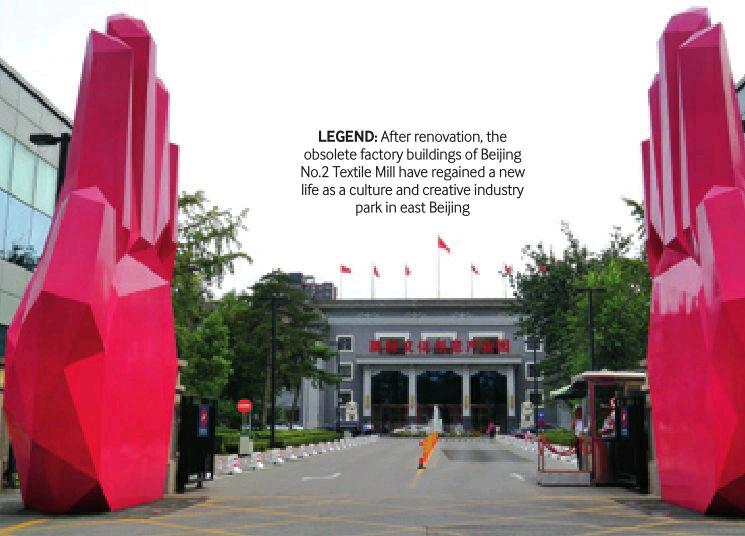Protecting Our Heritage
2014-09-23ByTangYuankai
By+Tang+Yuankai
Several kilometers east of Beijings central business district lies Legend Town, a culture and creative industry park transformed from an obsolete textile mill.
In the 1950s, the Beijing No.2 Textile Mill was established on this patch of land. The factory was the largest of its kind in China, and the first to use domestically developed textile equipment.
After the founding of the Peoples Republic of China in 1949, Beijing focused on developing its industry and built a number of factories. After the 1980s, the great capital city began to adjust its industrial structure by gradually moving many production facilities—including all textile mills—out of the downtown areas. The original sites of many of these factories have been developed into commercial residences or high-end office buildings.
The former site of the Beijing No.2 Textile Mill faced the same destiny, but it was luckier than other factory sites in that a distinctive plan for its reuse was eventually made. After consulting experts and conducting feasibility studies, the government of Chaoyang District, where the land is located, decided to renovate the old factory complex into a highend park for cultural and creative industries, particularly media and publishing, while preserving the history of the location.
Renowned Japanese designer Kengo Kuma was hired to oversee the project. He used techniques such as structural segmentation, natural illumination and vertical planting to transform the factory while retaining its original architectural features.
The old factory had several spacious workshops. The designer kept every main beam and column in these areas, and even their sawtooth-shaped roofs.
The old structures were also reinforced according to modern standards to make them quakeproof. Infrastructure such as its sewage system was also upgraded.
Legend Town gained its name as the renovation project was completed in March 2011. Now it is synonymous with success in industrial heritage preservation.
Neglected
When talking about cultural heritage, people tend to think of ancient relics. Industrial sites are generally considered as the places where people work rather than a source of heritage. As a result, preservation of industrial sites is often overlooked.
In recent years, a growing number of traditional industrial structures and facilities have faded into obscurity alongside Chinas rapid urbanization process and industrial restructuring. Amid soaring property prices and surging wave of commercial property development, some obsolete factories were torn down.endprint
Shan Jixiang, curator of the Palace Museum in Beijing, also known as the Forbidden City, and former head of the State Administration of Cultural Heritage, warned that industrial heritage has been disappearing at a faster rate than other historical sites.
According to Shan, the Chinese people had lived in an agricultural civilization for thousands of years, while over the past century or so, the introduction and development of modern industries in China has significantly changed peoples lifestyles and culture.
“Industrial heritage is an important part of the nations cultural heritage. We must attach importance to industrial heritage and protect it in the same way as other historical relics,” Shan noted.
Shan said that industrial heritage can be defined in a narrow sense as referring to industrial remains created after the Industrial Revolution, including sites, architectural structures, landscapes, machinery, documents and other objects, which have witnessed past or continuous industrial production processes, such as raw material processing and refining, commodity circulation, energy generation, transmitting and use, as well as transportation and all its infrastructure.
The Industrial Revolution started from the United Kingdom in the 18th century, and was mainly characterized by the use of such new-energy sources as coal and oil, as well as mechanical production.
In a broader sense, industrial heritage also includes processing, mining and handicraft sites used before the Industrial Revolution, including large pre-historical hydraulic projects and ancient sites for stone tool making and mining, according to Shan.
“Since the inception of the Industrial Revolution, production activities have greatly shaped urban landscapes. Due to industrial structure adjustment, some industries have gradually declined and their production sites have been abandoned. But they left behind a large amount of industrial heritage of historical and cultural value,” said Yu Kongjian, Dean of the College of Architecture and Landscape Architecture at Peking University.
Chinas industrial revolution commenced in the latter half of the 19th century and has created various forms of industrial heritage.
Currently in China, not enough attention has been paid to industrial heritage conservation, said Zhang Tinghao, former President of the Chinese Academy of Cultural Heritage.“If no action is taken, a large quantity of industrial relics will vanish. When people realize how valuable they are, they will be filled with regret,” he told national political advisors at a meeting during this years full session of the National Committee of the Chinese Peoples Political Consultative Conference in March.endprint
Zhang believes that for industrial workers and other urban residents, these plants and machines are more than bricks and steel, for they show how many generations of Chinese people have worked hard to realize their dreams.
“Although Chinas history of industrial development is only a little more than a century long, it has left us not only time-honored factory buildings, high furnaces, derricks and docks, but also the evidences of Chinas modernization process,” Zhang said.
Gradual progress
On May 29, the Industrial Heritage Committee of the China Society of Cultural Relics was set up, marking a milestone in the preservation of Chinas industrial heritage. The committee, staffed by experts in cultural relic preservation, urban planning, architectural design and cultural development and exhibition, will explore effective ways to protect and use industrial heritage sites.
Shan, also President of the China Society of Cultural Relics, delivered a keynote speech at the committees founding ceremony. He said that preserving industrial heritage is an important part of maintaining a citys history and its uniqueness.
“As part of human life, industrial heritage is of historical, social, scientific, technological and economic value,” Shan noted, “It may have considerable aesthetic value for the quality of its architecture, design or planning.”
In Shans eyes, industrial heritage sites bear diversified characteristics because they were constructed for different purposes and in different styles. They represent technological progress as well as regional and historical settings in different time periods, and carry forward intangible cultural heritage such as artifacts and customs, he said.
In terms of industrial heritage protection was new to the Chinese people. “In this area, we were 20 years behind European countries,” said Wen Zongyong, President of the Beijing Institute of Surveying and Mapping.
International efforts to protect industrial heritage started from the 1970s. In 2003, the International Committee for the Conservation of the Industrial Heritage adopted the Nizhny Tagil Charter, which defines industrial heritage and has become a guiding document for protection efforts worldwide.
In November 2011, the 17th General Assembly of the International Council on Monuments and Sites passed the Dublin Principles, which spell out standards for industrial heritage conservation. endprint
endprint
In response to international efforts in this area, in April 2006, Chinese government officials in charge of cultural relic preservation, representatives of cities rich in industrial heritage and experts in the field gathered in Wuxi, east Chinas Jiangsu Province, to mark International Day for Monuments and Sites, which carried the theme of industrial heritage. Wuxi is the cradle for Chinas traditional industry and township enterprises. Participants put forward the Wuxi Proposals for inscribing and protecting industrial heritage in China.
As of 2013, among the 4,295 key cultural relic sites inscribed by the State Council, 329 were industrial heritage sites, including 245 in a broad sense and 84 in the narrow sense.
Meanwhile, as of 2013, the UNESCOs World Heritage List includes 50 industrial heritage sites in 25 countries, while the 2,000-year-old Dujiangyan Irrigation System in southwest Chinas Sichuan Province is the countrys only such site on the list. Industrial heritage sites account for 5 percent of all heritage sites on UNESCOs list.
As China promotes ecological progress, urbanization and the building of a mod- erately prosperous society, it is attaching increasing importance to industrial heritage conservation.
Reusable
The reuse value of industrial heritage is the highest among all cultural heritages, according to Dong Wei, an architectural professor in Nanjing-based Southeast University. As a result, industrial heritage sites can be preserved in different ways from regular cultural relics, he added.
In recent years, China has recorded successful cases of industrial heritage protection. A number of ancient porcelain kilns in Jingdezhen in east Chinas Jiangxi Province, known as the countrys Porcelain Capital, have been put under protection while in operation. The earliest kilns date back more than 1,000 years.
The 798 Art Zone, Beijings leading concentration of contemporary art galleries, has been converted from a cluster of shuttered factories built in the 1950s. A water plant in Beijings downtown Dongzhimen area has been transformed into the Beijing Tap Water Museum.
While industrial heritage sites are reused, some problems have occurred. Zhan Erpeng, a deputy inspector with the Urban Planning Bureau of Qingdao, east Chinas Shandong Province, said that sometimes, industrial heritage sites are used as advertisements while their basic function as a cultural carrier has been marginalized.endprint
Industrial heritage protection should not be regarded as a passing trend, and the protection method should be customized and more imaginative, said Peking Universitys Yu, one of the major drafters of the Wuxi Proposals.
Currently, a major complaint among cultural relic experts is that the reuse of industrial heritage sites mainly focuses on transforming them into museums and creative industry parks, or even development of commercial properties.
The models of industrial heritage conservation should be diversified and resourceful, said Southeast Universitys Dong. He suggested that industrial heritage sites should be used reasonably and sustainably, and protection and urban development should be integrated, so that old memories can be retained amid rapid urban construction.
Shan said that industrial heritage protection should follow three standards: First, industrial heritage sites should be renovated and made attractive; second, they should be used to promote social and economic development; third, they should benefit the general public.
“Only if the general public can benefit from industrial heritage protection, will they become involved in it,” he said.endprint
